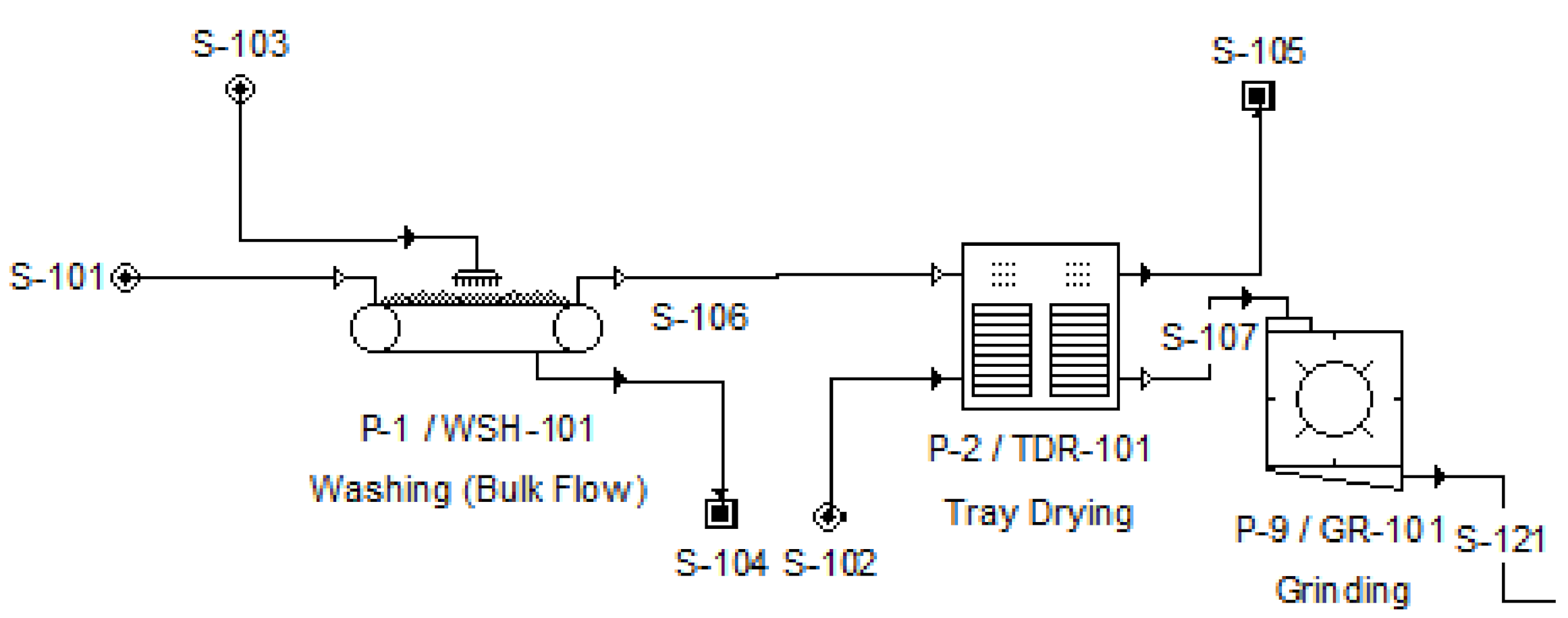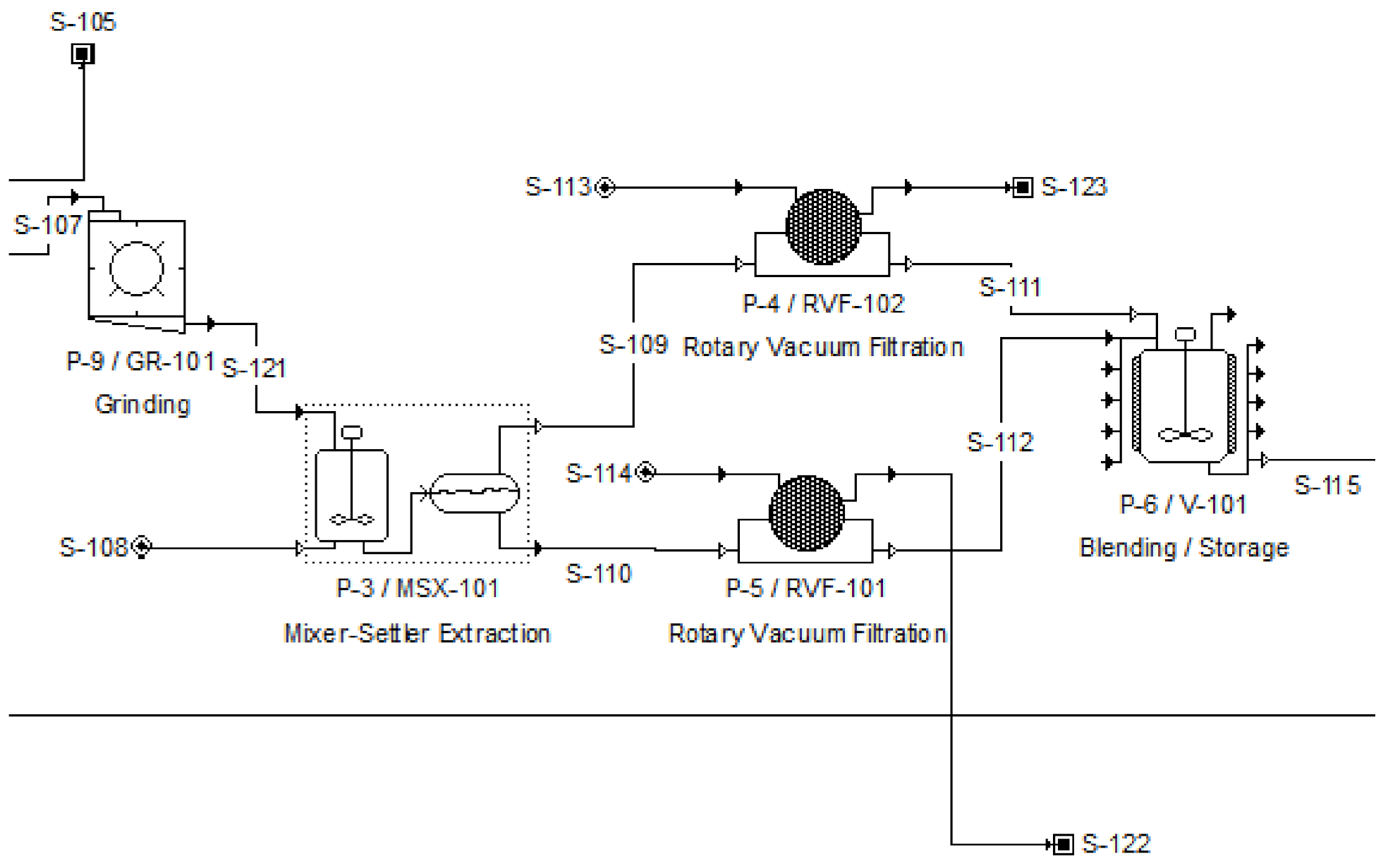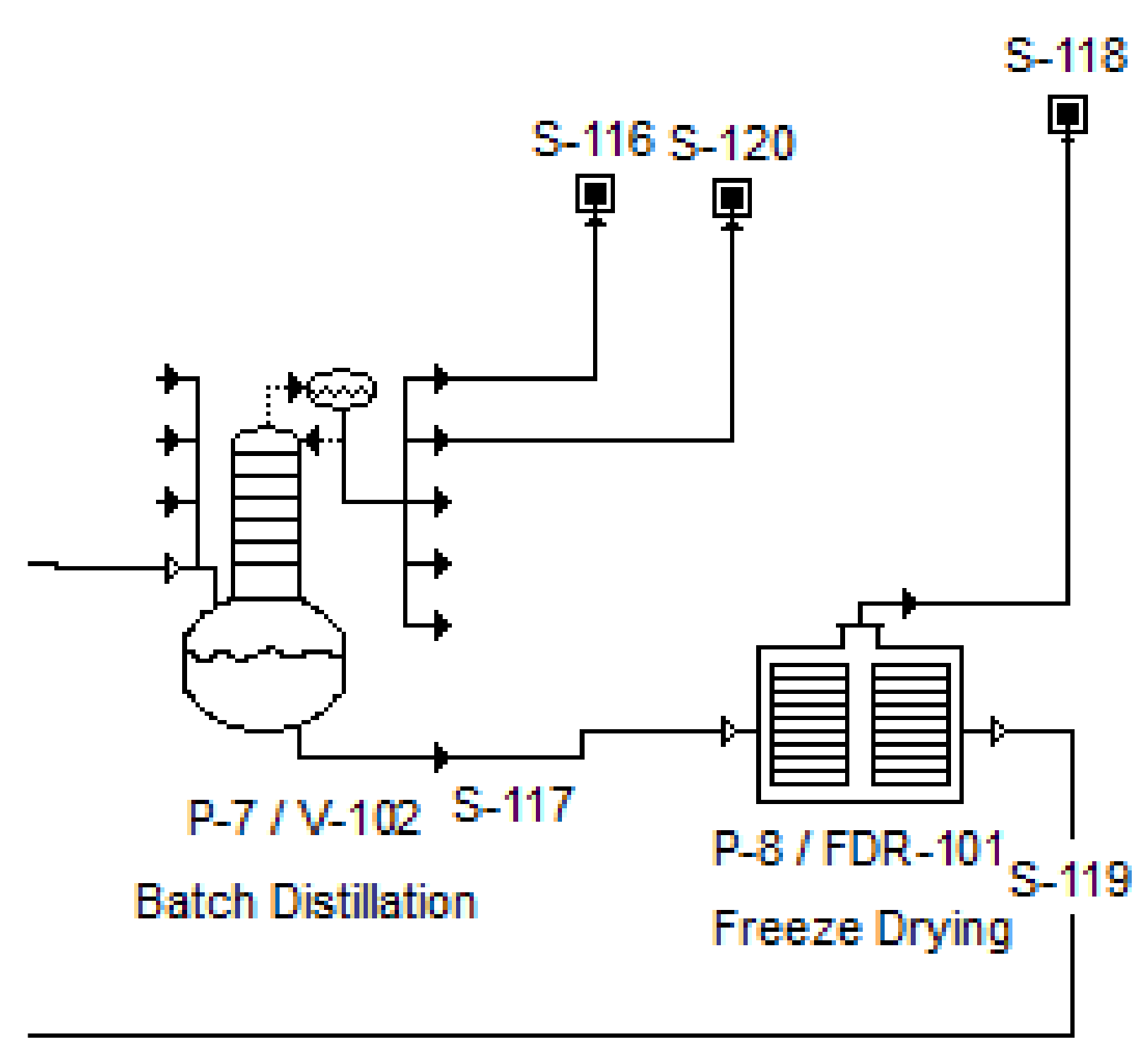Feasibility Assessment of an Encapsulated Longevity Spinach (Gynura procumbens L.) Extract Plant in Indonesia
Abstract
1. Introduction
2. Materials and Methods
2.1. Feedstocks
2.2. Process Design
2.2.1. Pre-Treatment Process
2.2.2. Main Process
2.2.3. Final Drying Process
2.2.4. Packaging Process
2.3. Economic Assessment
3. Results
3.1. Process Summary Result
3.2. Economic Summary Result
4. Discussion
5. Conclusions
Author Contributions
Funding
Institutional Review Board Statement
Informed Consent Statement
Acknowledgments
Conflicts of Interest
Appendix A
| Initial Volume (mL) | Final Volume (mL) | Evaporated Volume (mL) | Pressure (mbar) | Evaporation Efficiency (%) |
|---|---|---|---|---|
| 200 | 182 | 18 | 1013 | 9 |
| 140 | 60 | 110 | 30 | |
| 82 | 118 | 80 | 59 | |
| 80 | 120 | 60 | 60 | |
| 78 | 122 | 40 | 61 |
References
- Mittelman, M.; Hanaway, P. Globalization of healthcare. Global Adv. Health Med. 2012, 1, 5–7. [Google Scholar] [CrossRef]
- Farhud, D.D. Impact of lifestyle on health. Iran. J. Public Health 2015, 44, 1442. [Google Scholar]
- Barnes, B.J.; Adrover, J.M.; Baxter-Stoltzfus, A.; Borczuk, A.; Cools-Lartigue, J.; Crawford, J.M.; Daßler-Plenker, J.; Guerci, P.; Huynh, C.; Knight, J.S.; et al. Targeting potential drivers of COVID-19: Neutrophil extracellular traps. J. Exp. Med. 2020, 217, e20200652. [Google Scholar] [CrossRef]
- Zheng, M.; Gao, Y.; Wang, G.; Song, G.; Liu, S.; Sun, D.; Xu, Y.; Tian, Z. Functional exhaustion of antiviral lymphocytes in COVID-19 patients. Cell. Mol. Immunol. 2020, 17, 533–535. [Google Scholar] [CrossRef]
- Krystallis, A.; Chryssohoidis, G. Consumers’ willingness to pay for organic food: Factors that affect it and variation per organic product type. Br. Food J. 2005, 107, 320–343. [Google Scholar] [CrossRef]
- Lufesi, N.N.; Andrew, M.; Aursnes, I. Deficient supplies of drugs for life threatening diseases in an African community. BMC Health Serv. Res. 2007, 7, 86. [Google Scholar] [CrossRef] [PubMed]
- Mou, K.M.; Dash, P.R. A comprehensive review on Gynura procumbens leaves. Int. J. Pharmacogn. 2016, 3, 167–174. [Google Scholar]
- Afandi, A.; Sadikun, A.; Ismail, S. Antioxidant properties of Gynura procumbens extracts and their inhibitory effects on two major human recombinant cytochrome P450s using a high throughout luminescence assay. Asian J. Pharm. Clin. Res. 2014, 7, 36–41. [Google Scholar]
- Saeed, M.A.A.; Meng, K.Y.; Sadikun, A.; Murugaiyah, V.; Asmawi, M.Z.; Ismail, Z. Stability study of Gynura procumbens extracts using High Performance Liquid Chromatography. J. Pharm. Res. 2014, 8, 822–827. [Google Scholar]
- Akowuah, G.; Mariam, A.; Chin, J. The effect of extraction temperature on total phenols and antioxidant activity of Gynura procumbens leaf. Pharmacogn. Mag. 2009, 5, 81. [Google Scholar]
- Algariri, K.; Meng, K.Y.; Atangwho, I.J.; Asmawi, M.Z.; Sadikun, A.; Murugaiyah, V.; Ismaila, N. Hypoglycemic and anti–hyperglycemic study of Gynura procumbens leaf extracts. Asian Pac. J. Trop. Biomed. 2013, 3, 358–366. [Google Scholar] [CrossRef]
- Dwijayanti, D.R.; Rifa’i, M. Gynura procumbens ethanolic extract promotes lymphocyte activation and regulatory T cell generation in vitro. J. Trop. Life Sci. 2015, 5, 14–19. [Google Scholar]
- Tan, H.-L.; Chan, K.-G.; Pusparajah, P.; Lee, L.-H.; Goh, B.-H. Gynura procumbens: An overview of the biological activities. Front. Pharmacol. 2016, 7, 52. [Google Scholar] [CrossRef] [PubMed]
- Savitri, E.S.; Khusnia, F. Growth and Flavonoid Content of Gynura procumbens (Lour) Merr. in Different Soil Water Content. J. Biodjati 2019, 4, 298–304. [Google Scholar] [CrossRef]
- Nur, H.; Achmadi, T.; Mercy, K. Analysis of Seven International Indonesian Hub Ports Policy Development Impact on Shipping and Port Sector. In IOP Conference Series: Earth and Environmental Scienceed; IOP: Bristol, UK, 2020; p. 012061. [Google Scholar]
- Steinmetz, K.L.; Spack, E.G. The basics of preclinical drug development for neurodegenerative disease indications. BMC Neurol. 2009, 9, S2. [Google Scholar] [CrossRef]
- Stillman, J., Sr.; Burret, J.; Stonehill, H.; Perreault, S.; Boeckmann, C. Planting, Growing, and Harvesting Spinach. Available online: https://www.almanac.com/plant/spinach (accessed on 14 April 2021).
- Kaewseejan, N.; Siriamornpun, S. Bioactive components and properties of ethanolic extract and its fractions from Gynura procumbens leaves. Ind. Crop. Prod. 2015, 74, 271–278. [Google Scholar] [CrossRef]
- Garcia-Maraver, A.; Salvachúa, D.; Martínez, M.; Diaz, L.; Zamorano, M. Analysis of the relation between the cellulose, hemicellulose and lignin content and the thermal behavior of residual biomass from olive trees. Waste Manag. 2013, 33, 2245–2249. [Google Scholar] [CrossRef]
- Puangpronpitag, D.; Chaichanadee, S.; Naowaratwattana, W.; Sittiwet, C.; Thammasarn, K.; Luerang, A.; Kaewseejan, N. Evaluation of nutritional value and antioxidative properties of the medicinal plant Gynura procumbens extract. Asian J. Plant Sci. 2010, 9, 146–151. [Google Scholar] [CrossRef]
- Riadini, R.K.; Sidharta, B.B.R.; Pranata, F.S. Test of Antioxidant Activity of Connected Leaf Extract (Gynura procumbens (Lour.) Merr.) Based on the Difference of Extraction Method and Harvesting Age; Universitas Atma Jaya Yogyakarta: Yogyakarta, Indonesia, 2015. [Google Scholar]
- Neamţu, B.; Chicinaş, H.; Marinca, T.; Isnard, O.; Pană, O.; Chicinaş, I. Amorphisation of Fe-based alloy via wet mechanical alloying assisted by PCA decomposition. Mater. Chem. Phys. 2016, 183, 83–92. [Google Scholar] [CrossRef]
- Sinaga, M.S.; Siagian, P.D.; Ariska, R. Utilization of Nyawa Leaves Extract (Gynura Procumbens [Lour]. Merr) as Antioxidant in Coconut Oil using Methanol Solution. J. Tek. Kim. USU 2017, 6, 41–47. [Google Scholar]
- Wu, B. CFD Analysis of Mechanical Mixing in Anaerobic Digesters. Trans. ASABE 2009, 52, 1371–1382. [Google Scholar] [CrossRef]
- Shamsuddin, N.; Das, D.B.; Starov, V.M. Filtration of natural organic matter using ultrafiltration membranes for drinking water purposes: Circular cross-flow compared with stirred dead end flow. Chem. Eng. J. 2015, 276, 331–339. [Google Scholar] [CrossRef]
- Kossik, J. Small scale continuous cake filtration using the disposable rotary drum filter. Filtr. Sep. 2003, 40, 26–27. [Google Scholar]
- Hibbert, K.; Weilbert, C.; O’Leary, T. Rotary drum vacuum filters for production of wallboard-grade gypsum. In Expert Environmentaled; Komline-Sanderson: Peapack, NY, USA, 2018. [Google Scholar]
- Kshirsagar, V.; Tchessalov, S.; Kanka, F.; Hiebert, D.; Alexeenko, A. Determining maximum sublimation rate for a production lyophilizer: Computational modeling and comparison with ice slab tests. J. Pharm. Sci. 2019, 108, 382–390. [Google Scholar] [CrossRef] [PubMed]
- Shenoy, P.; Xanthakis, E.; Innings, F.; Jonsson, C.; Fitzpatrick, J.; Ahrné, L. Dry mixing of food powders: Effect of water content and composition on mixture quality of binary mixtures. J. Food Eng. 2015, 149, 229–236. [Google Scholar] [CrossRef]
- Setyawan, D.; Widjaja, B.; Ningtyas, Z.F. The Effect of Avicel PH 102 on Physical Characteristics and Dissolution Rate of Orally Disintegrating Piroxicam Tablets Using Direct Printing Method. Pharm. Sci. Res. PSR 2014, 7, 9–16. [Google Scholar]
- Indonesian Food and Drug Agency. The Standard Requirement and Quality for Traditional Medicine Products; Indonesian Food and Drug Agency: Jakarta, Indonesia, 2019; p. 26. [Google Scholar]
- Tristantini, D.; Robbani, S.; Santoso, L.L.; Elya, B. Acceptable Shelf Life of Indonesian Anti-Atherosclerosis Mixed Herbs Based on Bacterial Count and pH Stability. Int. J. Technol. 2020, 11, 784–793. [Google Scholar] [CrossRef]
- Osorio, F.A.; Molina, P.; Matiacevich, S.; Enrione, J.; Skurtys, O. Characteristics of hydroxy propyl methyl cellulose (HPMC) based edible film developed for blueberry coatings. Procedia Food Sci. 2011, 1, 287–293. [Google Scholar] [CrossRef]
- Achinas, S.; Leenders, N.; Krooneman, J.; Euverink, G.J.W. Feasibility assessment of a bioethanol plant in the northern Netherlands. Appl. Sci. 2019, 9, 4586. [Google Scholar] [CrossRef]
- Prayoga, R. Indonesian Central Statistical Bureau’s Census Result: 71.98 Percent of Jakarta Citizen Are in the Productive Age; Antara: Jakarta, Indonesia, 2021. [Google Scholar]
- Astuti, I. Jakarta Has the Highest Prevalence of Diabetes; Media Indonesia: Jakarta, Indonesia, 2018. [Google Scholar]
- Back of the Envelope Analysis. In BEA Depreciation Rates, Service Lives, and Declining-Balances Rates; US Department of Commerce: Washington, DC, USA, 2021.
- Algariri, K.; Atangwho, I.J.; Meng, K.Y.; Asmawi, M.Z.; Sadikun, A.; Murugaiyah, V. Antihyperglycaemic and toxicological evaluations of extract and fractions of Gynura procumbens leaves. Trop. Life Sci. Res. 2014, 25, 75. [Google Scholar]
- Upadhyaya, A.; Gupta, B.; Garg, S.; Singh, M.; Pandey, M. Study of Moisture Depletion Pattern of Spinach in Hot Air Oven. Int. J. Eng. Res. Appl. 2012, 2, 301–310. [Google Scholar]
- Lidwina, A. Indonesian People Groups Classification Based on Their Cost Expenditure; Katadata: Jakarta, Indonesia, 2020. [Google Scholar]
- Ismail, I. Factors Influencing Community Decisions to Choose Traditional Medicine in Lam Ujong Village. Idea Nurs. J. 2015, 6, 7–14. [Google Scholar]
- Endarwati, O. Conventional and Traditional Pharmaceutical Companies Are Projected to Have 9% Growth; Sindonews.com: Jakarta, Indonesia, 2019. [Google Scholar]
- Tu, N.; Adiputranto, D.; Fu, X.; Li, Z.-C. Shipping network design in a growth market: The case of Indonesia. Transp. Res. Part E Logist. Transp. Rev. 2018, 117, 108–125. [Google Scholar] [CrossRef]
- Wijayanti, R. Cultivation of Longevity Spinach (Gynura procembens (lour.) Merr.) and its Properties in Indmira Yogyakarta, Inc. Final Project; Universitas Sebelas Maret: Surakarta, Indonesia, 2012. [Google Scholar]
- Huang, X.-L.; Li, X.-J.; Qin, Q.-F.; Li, Y.-S.; Zhang, W.K.; Tang, H.-B. Anti-inflammatory and antinociceptive effects of active ingredients in the essential oils from Gynura procumbens, a traditional medicine and a new and popular food material. J. Ethnopharmacol. 2019, 239, 111916. [Google Scholar] [CrossRef]
- McAlpine, C.; Syktus, J.; Ryan, J.; Deo, R.; McKeon, G.; McGowan, H.; Phinn, S.R. A continent under stress: Interactions, feedbacks and risks associated with impact of modified land cover on Australia’s climate. Glob. Chang. Biol. 2009, 15, 2206–2223. [Google Scholar] [CrossRef]
- Amalan, V.; Vijayakumar, N.; Ramakrishnan, A. p-Coumaric acid regulates blood glucose and antioxidant levels in streptozotocin induced diabetic rats. J. Chem. Pharm. Res. 2015, 7, 831–839. [Google Scholar]
- Mazloom, Z.; Abdollah, Z.S.M.; Dabbaghmanesh, M.H.; Rezaianzadeh, A. The effect of quercetin supplementation on oxidative stress, glycemic control, lipid profile and insulin resistance in type 2 diabetes: A randomized clinical trial. J. Health Sci. Surveill. Syst. 2014, 2, 8–14. [Google Scholar]
- Peungvicha, P.; Temsiririrkkul, R.; Prasain, J.K.; Tezuka, Y.; Kadota, S.; Thirawarapan, S.S.; Watanabe, H. 4-Hydroxybenzoic acid: A hypoglycemic constituent of aqueous extract of Pandanus odorus root. J. Ethnopharmacol. 1998, 62, 79–84. [Google Scholar] [CrossRef]
- Kilani-Jaziri, S.; Mokdad-Bzeouich, I.; Krifa, M.; Nasr, N.; Ghedira, K.; Chekir-Ghedira, L. Immunomodulatory and cellular anti-oxidant activities of caffeic, ferulic, and p-coumaric phenolic acids: A structure–activity relationship study. Drug Chem. Toxicol. 2017, 40, 416–424. [Google Scholar] [CrossRef]
- Gozan, M.; Ramadhan, M.Y.A.; Harahap, A.F.P.; Sari, C.N.; Muharam, Y.; Purwanto, W.W.; Tristantini, D. Techno-Economic Analysis of Healthy Herbal Ice Cream Product. Int. J. Technol. 2020, 11, 931–940. [Google Scholar] [CrossRef]



| Component Name | Mass Composition (%) |
|---|---|
| Cellulose | 9.490 |
| Hemi-cellulose | 8.450 |
| Lignocellulose | 39.810 |
| p-Hydroxybenzoic acid | 0.003 |
| p-Hydroxycinnamic acid | 0.027 |
| Quercetin | 0.002 |
| Water | 36.628 |
| Component Name | Mass Composition (mg) | Mass Percentage (%) |
|---|---|---|
| Avicel ph-101 | 194 | 32.61 |
| Ash content | 279.96 | 47.05 |
| Hypromellose | 100 | 16.8 |
| p-Hydroxybenzoic acid | 1.59 | 0.27 |
| p-Hydroxycinnamic acid | 14.34 | 2.41 |
| Sodium benzoic acid | 1 | 0.17 |
| Quercetin | 1.06 | 0.18 |
| Water content | 3.05 | 0.51 |
| TOTAL | 595 | 100 |
| Process Conditions | Washing | Drying | Grinding | Extraction | Filtration | Evaporation | Freeze-Drying |
|---|---|---|---|---|---|---|---|
| Equipment (units) | 1 unit | 2 units | 2 units | 2 units | 2 units | 2 units | 5 units |
| Temperature (°C) | 25 | 60 | 25 | 50 | 25 | 50 | 12 |
| Pressure (atm) | 1 | 1 | 1 | 1 | 1 | 0.05 | 0.05 |
| Time (min) | 20 | 30 | 10 | 60 | 60 | 60 | 390 |
| Efficiency | - | 86.4 | - | 88.97 | 49.99 | 61.15 | 99.3 |
| Process Details | Using tap water | Only removes water content | Provides uniformity of size | Using drinking water and agitation | Using rotary vacuum filtration | Only removes water content | Only removes water content |
| Plant Summary | Value |
|---|---|
| Total capital expenditure (USD) | 598,127.77 |
| Operational cost (USD/year) | 819,735.03 |
| Revenues (USD/year) | 1,928,217.68 |
| Batch size (kg) | 0.251 |
| Batch quantities/day | 15 |
| Feedstock (kg/day) | 720 |
| Conversion (%) | 0.52 |
| Production rate (bottles/year) | 26,082 |
| Payback period (months) | 17 |
| IRR (after taxes) (%) | 91.65 |
| NPV (at 9.95% interest) (USD) | 3,972,653,13 |
Publisher’s Note: MDPI stays neutral with regard to jurisdictional claims in published maps and institutional affiliations. |
© 2021 by the authors. Licensee MDPI, Basel, Switzerland. This article is an open access article distributed under the terms and conditions of the Creative Commons Attribution (CC BY) license (https://creativecommons.org/licenses/by/4.0/).
Share and Cite
Tristantini, D.; Setiawan, H.; Santoso, L.L. Feasibility Assessment of an Encapsulated Longevity Spinach (Gynura procumbens L.) Extract Plant in Indonesia. Appl. Sci. 2021, 11, 4093. https://doi.org/10.3390/app11094093
Tristantini D, Setiawan H, Santoso LL. Feasibility Assessment of an Encapsulated Longevity Spinach (Gynura procumbens L.) Extract Plant in Indonesia. Applied Sciences. 2021; 11(9):4093. https://doi.org/10.3390/app11094093
Chicago/Turabian StyleTristantini, Dewi, Heri Setiawan, and Leon Lukhas Santoso. 2021. "Feasibility Assessment of an Encapsulated Longevity Spinach (Gynura procumbens L.) Extract Plant in Indonesia" Applied Sciences 11, no. 9: 4093. https://doi.org/10.3390/app11094093
APA StyleTristantini, D., Setiawan, H., & Santoso, L. L. (2021). Feasibility Assessment of an Encapsulated Longevity Spinach (Gynura procumbens L.) Extract Plant in Indonesia. Applied Sciences, 11(9), 4093. https://doi.org/10.3390/app11094093





